Introduction
Tomato and cucumber are popular and important crops for greenhouse production in Florida. Profitability from production of tomato and cucumber requires attention to the many details of crop culture. The major keys to successful greenhouse production of tomato and cucumber are presented in this publication. This guide is directed at the small to medium-sized grower with one to several houses, but much of the information is also useful for larger operations. The information in this guide focuses on tomato (Figure 1 and Figure 2) and cucumber (Figure 3 and Figure 4), but also applies to other crops grown in soilless media, including pepper, eggplant, melons, lettuce, and cut-flowers (Figure 5, Figure 6, and Figure 7). Although this guide focuses on perlite media in lay-flat bags, most of the principles also pertain to other soilless media, such as rockwool slabs and peat-mix bags (Figure 8). In addition, many of these principles apply to using perlite, pine bark, or similar media in containers, such as nursery containers. More details on each subject, including suppliers, irrigation, greenhouse management, marketing, etc., are available from the Florida Greenhouse Vegetable Production Handbook chapter guides found at https://edis.ifas.ufl.edu, and at http://smallfarms.ifas.ufl.edu.





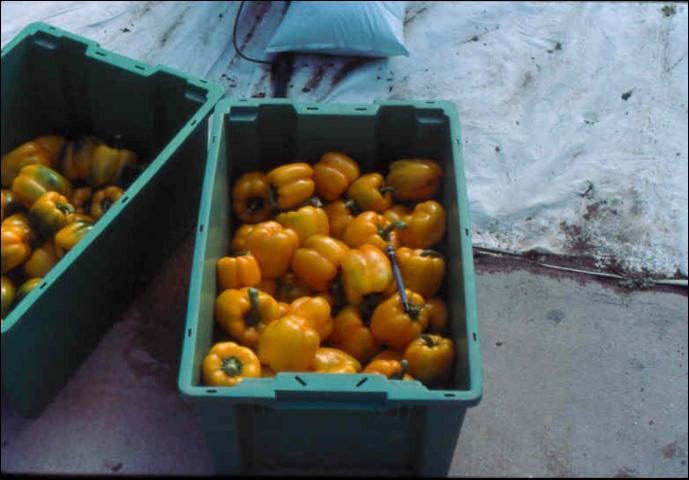


Perlite
What is it? Perlite is a mined mineral that is crushed, then expanded under high temperature. The crushed material expands like popcorn, is cooled, and sieved into various grades based on particle size. Perlite is white in color, very light weight, and has high water holding capacity and high aeration properties (Figure 8).
Sources. Perlite is locally available in Florida (please see a list of greenhouse suppliers at https://edis.ifas.ufl.edu/hs255). Price and sales support might vary among perlite suppliers. There are negligible differences in grades of perlite as far as crop performance is concerned. Most crops grow equally well in coarse or medium size horticultural grade perlite.
Availability. Perlite can be purchased ready to use in pre-made, lay flat bags, approximately three feet long, six to eight inches wide, and four inches tall (Figure 9). Perlite also can be purchased in bulk pallet bags or in medium-sized bags of about four cubic feet. Growers can then purchase rolls of polyethylene sleeving material from greenhouse supply companies and make up their own growing bags. The sleeving material should be black-on-white with black on the inside to minimize light penetration inside the bag.
Media Re-use. Re-use of unsterilized perlite is risky. Cost in re-use (handling, sterilization, rewrapping) is significant. High levels of organic matter in re-used media might affect the irrigation scheduling program early in second crop season. Re-used media holds more water because of organic matter (old roots). Old root material might harbor disease organisms from previous crops.
Bag Positioning. In double-row systems, bags are placed on a very slight incline toward leachate collection trough (Figure 9 and Figure 10). An alternative system uses a single bag from which plants are positioned toward two overhead trellis wires so two rows of plants are created. In the single-bag system, care should be taken to provide adequate media volume per plant. Both systems have been successfully used in Florida. Once bags have been placed in the greenhouse, the perlite media should be thoroughly wetted by allowing the irrigation system to apply plain water. Once wetted, the drainage slits can be made in the bags.


Drainage. Small slits should be made in the near bottom of the bags so that excess water will not build up and drown roots. A large reservoir of water in the bag is not required so slits can be positioned to provide nearly complete drainage. A large reservoir maintained in the bag only reduces the volume of aerated root zone, which plants need to grow optimally.
Transplanting. Transplants for the perlite system can be produced in several media types including rockwool, perlite, or vermiculite (Figure 11). The large rockwool growing blocks are not needed in Florida. Care should be taken to completely bury the root media ball of the transplant so that the perlite media in the bag does not wick the moisture from the transplant ball. This is why rockwool growing blocks should not be placed on the surface of the perlite media. Irrigation emitters must immediately be placed in position and directed to wet the perlite nearest the root ball of the transplant. Later on, in a few weeks, the emitter can be moved back a few inches from the transplants.

Cucumbers can be transplanted into growing bags, however, cucumbers also can be seeded directly into the perlite bags. The germination percentage of cucumber seeds is good enough that direct-seeding can result in near 100% stands. Direct-seeding saves considerably on transplant production costs and the challenges associated with production of high quality transplants. Growers might wish to start about 5% of their cucumber crop in transplants so that direct-seeded plants that fail to emerge and develop can be replaced with a growing transplant.
Irrigation Program
Water Quality. Obtain an analysis of your well water for bicarbonates, pH, iron, sulfur, calcium, and magnesium. Water analysis helps determine problems to be anticipated from emitter clogging (fertilizer precipitation and lime deposits, and bacterial slimes). Plants can use the calcium; knowledge of calcium concentrations can help with fertilizer program. Sometimes, we might want to reduce the amount of calcium nitrate (Ca) if Ca is high in water. Plant leaf analysis should be used to monitor the fertilizer program or to diagnose nutrient deficiencies. For tomatoes, sample the most-recently-matured leaf (about the sixth leaf back from the tip). Sample the whole leaf including the petiole that attaches it to the main stem (just as if removing a leaf for the leaning and lowering process). Try sap analysis for nitrogen and potassium (Figure 12). Sap squeezed from the petiole of the most-recently-matured leaf should read 600 to 1000 ppm nitrate-nitrogen. Ask your local UF/IFAS Extension agent for help if you are interested in sap testing. More information on petiole sap testing can be found in Circular 1144 from UF/IFAS Extension or on-line at https://edis.ifas.ufl.edu/cv004.

Watering. Irrigation programs for tomatoes growing in perlite can be controlled by the same equipment originally designed for tomatoes in rockwool. The irrigation sequences (number and length) can be controlled by a timer set to operate the irrigation system a set number of times during the day for a predetermined length of time. As long as enough water and nutrients can be supplied to the crop, you will be successful in production. The problem with control by timer is that plants will get water and nutrients whether they need the water or nutrients or not.
Perlite-grown plants can be irrigated by a starter-tray set-up like rockwool (Figure 13). We have had good success using the start-tray and similar management schemes to those for rockwool. Several (40 to 50) small slits are made in the bottom of a perlite bag and the bag formed into the start tray. For more information on irrigation, consult the list of references at the end of this guide.

The approach to fertilizer and water management, with either timer or start-tray, is to apply enough water and enough nutrients at the correct time of crop requirement. Usually we start early in the season with nutrient solutions low (60 to 80 ppm) in N concentrations. Frequent, short irrigations will supply enough total nutrients to the crop. If a timer is used and irrigations are infrequent (once or twice per day), then a more concentrated (100 ppm) nutrient solution might be needed.
Fully grown tomato plants may use two to three pints of water per day in the winter (including that for leaching) and three to five pints on warm spring days.
The key to watering frequency is to balance the amount needed by the crop with the total needed for crop and leach. A general rule-of-thumb is to leach about 10 to 15% at each irrigation event for tomato. Leaching rate for cucumber might need to be 20%. Leaching is needed to minimize salt buildup in the media and to assure all bags are fully wetted with each irrigation.
What about media salt content? High concentrations of salts in the perlite media can damage plant roots and upset nutrient and water uptake by roots. Tomatoes can tolerate fairly high soluble salt content in the root zone; cucumbers are less tolerant. As water is absorbed by plants, some salts are left behind in the media. These salts are mostly carbonates and sulfates, e.g. calcium sulfate, calcium carbonate (lime), and magnesium carbonate. If you are applying a nutrient solution with an electrical conductivity (EC) of 1.0 decisiemens/meter, you can tolerate a media EC of 1.5. If you are applying a solution of 2.0 EC (full-grown plants), then you can tolerate a media EC of 2.5 to 2.8. The key is to watch the EC trends and begin corrective measures if it continues to climb. Climbing EC indicates the need to increase frequency of irrigation (more water) by raising the probe setting of the starter tray or increasing the irrigation run time. Remember, the idea is to balance amount of water needed by the crop with that needed by the crop plus leach. Maintaining the EC of the media slightly above the delivered solution shows that you are a good manager of nutrient solution delivery.
It is a good idea to have a few milk jugs positioned around the house with an extra emitter punched in. Paint the jug black to reduce algae growth and then scratch a clear line from top to bottom of the jug so you can see the solution level. Calibrate the mark by sequentially pouring in pints of water and marking each pint level. The jug helps tell you that the system came on that day and it can tell you how much water was applied. With experience, you can tell how much solution should be in the jug on a cloudy day versus a sunny day or on a winter day versus a spring day. Several jugs around the house can help you get an idea of emitter flow rate uniformity. You might have problems if variance among emitters is greater than 15%. Get into the habit of performing the "bag slap test." Pick up the corner of one bag and flop it up and down a couple of times to get the feel for its weight. Check a random six bags per house every day or so. Lightweight bags indicate not enough irrigation or clogged emitters.
Be sure the emitter spaghetti tube length and that of the emitter plugged in for the jug, are the same length and size as those for the plants. Otherwise, a different flow rate could result. Also, be sure to position the opening of the emitter, or tube in the milk jug, so that the opening is above the level of the irrigation line in between the rows. Otherwise, siphoning (forward or backward) could result in giving false jug readings.
Check emitter flow rate and uniformity periodically. Using a graduated cylinder or a measuring cup, collect solution as it is delivered for several emitters about the house and check for uniformity. They should be within 10 to 15% of each other. Also, measure flow rate—amount of solution delivered in 15 seconds, for example. This can help determine how long to run the system each cycle. Remember the idea is to achieve about 10 to 15% of leach and to manage the media EC slightly higher than the delivered EC. It takes time and experience to get all the pieces together. Early season irrigation program is different from full-grown plants. Young seedlings do not have large root systems in the media. Therefore, young seedlings (up to about first blossom) will need to be irrigated on timed basis instead of by the starter tray. Irrigate at least three times a day with enough solution to wet the young root system to encourage roots into the media. After roots become established in the perlite, then control can be switched over to the starter tray (Figure 14).

What about starter tray probe settings? Generally, shallow setting is for frequent irrigations and deeper setting is for less frequent irrigations. Probe setting is one way to adjust the irrigation cycles to achieve the desired leach rate, to achieve the desired amount of water for the plant, and to manage the soluble salt level in the media.
Sometimes, a salt deposit builds up on the probe point. This should be removed regularly as it, in effect, lengthens the probe. Also, algae and bacterial slime might build up in the probe reservoir. Slimes might create a strand from the reservoir to the probe, thus maintaining contact between solution and probe, thus reducing irrigation cycle frequency. Also, roots can grow into the reservoir and should be trimmed back.
The starter tray should be placed in an area of the house representative of the house environment, generally at least 1/4 of the distance from end walls (Figure 15). Place the tray in an alley that receives frequent traffic, where it will be observed daily. Many growers do not observe their tray frequently enough.

Record Keeping
Good Growers Do It. The most consistent and best producing growers are the ones that practice good record keeping (Figure 16). Records help diagnose trends and problems during the present season and they are invaluable for helping prevent repeat problems next season. Important items for regular insertion in the record book are:
- Max-min temperatures outside and inside the greenhouse.
- Heating fuel consumption.
- "Milk jug" measurements.
- Delivered solution EC, pH, and nutrient solution concentrations, e.g. N and K.
- Leachate EC and nutrient concentrations.
- Flow meter readings.
- Light meter readings.
- Plant tissue analysis results, e.g. sap readings.
- Emitter flow rates and uniformity measurements.
- Fertilizer stock recipes and any adjustments.
- Volume of leach tank pump out.

Observe, Observe
"Read" the Plants. Learn to anticipate potential problems before they occur. Experienced growers know what healthy plants look like. But be careful here that you do not associate green, vigorous plants with higher yield. Sometimes overly green, bullish, and thick plants are not what you want and can actually be an indicator themselves of a problem (too much fertilizer). Overly-vegetative plants are more difficult to manage, more prone to disease, more prone to breakage, and typically have more problems with fruit quality (Figure 17).

Knowing what kind of plant will produce the best fruit with the least trouble is the most important key to being a successful grower. This means that you must devote a portion of each day to being a plant reader and record taker. Write out notes in your record book about what you did today (sort of a diary). You will be glad you did when it comes time to diagnose a problem. Read your book from last year before you start up the new season, and read the old book periodically throughout the new season to see what the problem was last year and what you did to correct it.
Attention to detail most often sets the good (and profitable) growers apart from the rest. Being observant, recording, and reacting to what you observe are requisites for successful greenhouse vegetable growing.
Irrigation System Design
Pieces and Parts. The irrigation system needs to have all the required parts and in the correct design. You need a backflow prevention system (check valve, pressure relief, and low pressure drain) for systems into which fertilizers are to be proportioned.
Correctly designed systems allow for emitters in the house to have uniform flow rate. All parts should be sized properly.
The system should have pressure regulators and pressure gauges. Also a flow meter would be a good idea to back up milk jug measurements.
What about emitter type and size? The key is emitter orifice size. For Florida water, clogging can be a problem if the emitter orifice is too small. Therefore, it is suggested that the opening to the emitter be at least 0.05 inches in diameter. Options range from pressure compensating "button" emitters to simple "water sticks" that project a stream of solution from spaghetti tubing (0.05 inches inner diameter) (Figure 18). It is probably a good idea to have an emitter with a fairly high flow rate to minimize run time of the system and minimize chance of clogging.

Lines should be equipped with flush valves at the end. Open valves every week to flush out collected precipitates that might clog emitters.
All good irrigation systems filter the water delivered to the house. Filtration should be about 200 mesh. Filtering protects the proportioners or injectors from damage, from sand or limestone, from the well, and protects emitters from clogging. Fertilizer from the stock tanks also should be filtered. Also, be sure to use filtered water in the formulation of the fertilizer stocks. Filters should be in black housing to reduce algae growth in the filter. Always check and clean filters regularly; otherwise flow rate of water will be reduced.
Fertilizers are added to the water by injectors or proportioners. Typically proportioners are used in smaller-sized growing operations. Injectors typically are used with systems involving computer control technologies. Proportioners can be used on small-scale operations because they are relatively inexpensive and operate on the water pressure, not requiring electric control.
Both parallel and series installations of proportioners can be used successfully. Proportioners can be installed in parallel to avoid problems associated with pressure losses across serial proportioners. Parallel installation can also be used if more water is needed than the maximum delivery of one proportioner.
Valves installed after each proportioner can be adjusted to equalized suction rates. Keep an eye on stock levels to be sure proportioners are operating equally. Also, check the nitrogen and potassium levels in the emitters to be sure the proportioners are operating correctly.If you have nitrogen and potassium electrode kits, it might be a good idea to have all nitrogen in one stock and all potassium in the other stock (Figure 19). That way you can determine which proportioner is malfunctioning and to what degree, by checking N and K concentrations in the stock tanks.
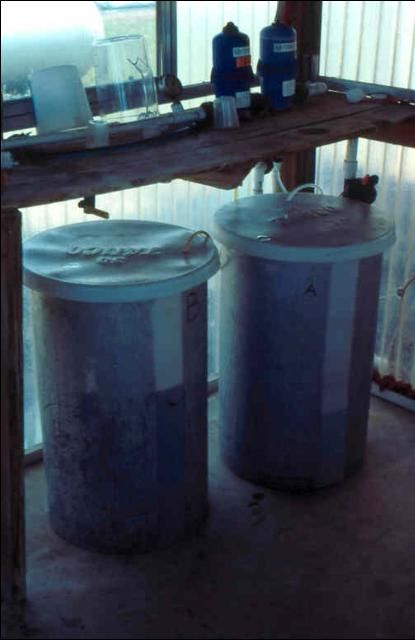
Injectors are typically used with larger operations in conjunction with computer control. Injectors can be operated by the computer controller to inject various amounts of various fertilizers and chemicals on demand from a computer program.
Back-up Parts. It is always a good idea to have spare parts around, especially for the more important components such as proportioners, solenoid valves, pressure regulators, emitters, filters, etc. It seems as though things break down on weekends, or worse yet, on holidays.
Weather Problems
Media Temperature. We have observed problems with plants such as wilting, iron deficiency, reduced growth, etc., when the media temperature drops below 65°F. This can happen during extended cloudy and cold periods. Cool temperatures in the root zone reduce water and nutrient uptake. Plants can wilt on a sunny day immediately following a cool, cloudy period. If this is a problem, you might want to consider a bottom or floor heat distribution system to help warm the root area. Also, raising bags up onto benches two or three inches from the floor, so that there is air space, will help insulate media from the cool floor. Media temperature is extremely important for proper plant growth (Figure 20, Figure 21, Figure 22, and Figure 23). Temperature sensors and warning or alarm systems are a good investment (Figure 24).
Sunlight. Extended cloudy and cool days might cause too much delay in irrigation cycling. You might need to force the system on for a few cycles on these days. Remember, plants grow slower on these days so they do not need large amounts of nutrients and water, but they do require some.
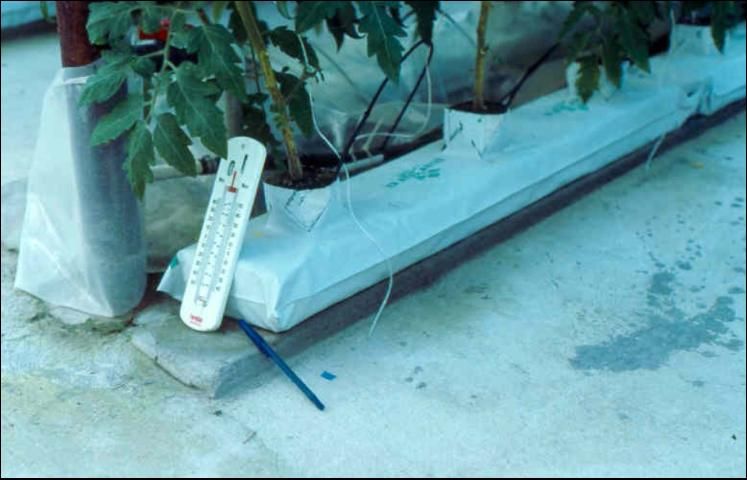



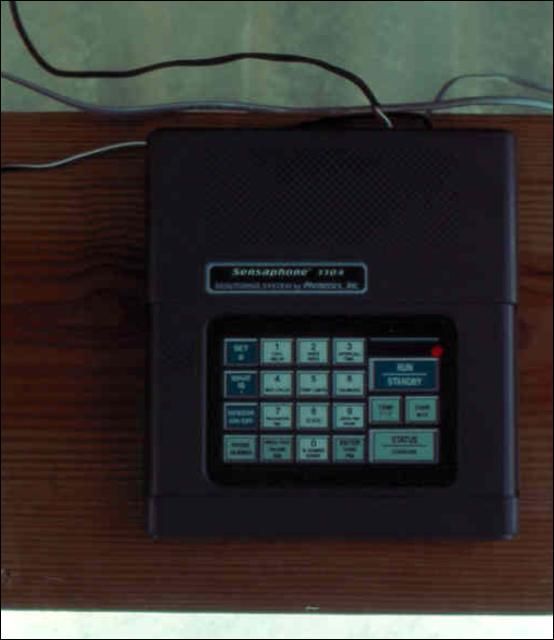
Leachate Collection
System Design. Environmental concerns will probably dictate that leachate be collected and disposed of properly. Bags should drain into a collection trough and leachate should be removed from the house (Figure 10 and Figure 25). Leachate can be collected in a large tank and used to irrigate pasture, garden, vegetable crops, pine trees, nurseries, etc. If the irrigation system is being operated properly, as discussed earlier, then leachate should be relatively low in nutrients but still would represent a potential point-source for pollution, if not disposed of properly.

Computerization
Who Needs It? Computerized controllers can be a good investment for some growers; however, electronic controllers are a good investment for all growers. It depends on your size, on how many other functions (besides water and nutrient programs) you want controlled, and on how much information (data) you want collected and stored. Small, one, two, or three-house operations can usually do quite well with simple electronic controllers for their irrigation systems. Larger operations can benefit from the control level and data collection afforded by computerized systems. Computer-controlled systems collect readings of several environmental variables, e.g. temperature, relative humidity, sunlight intensity, etc. These measurements are analyzed by the computer and decisions are made concerning environmental controls, for example, turning on or off the exhaust fans, deploying shade cloth, or operating the irrigation system. As the computer uses the data it collects to operate the environmental controls, also it stores those data for analysis and reporting to the greenhouse operator.
Pest Control
Greenhouse crops are very good hosts for diseases, insects, and nematodes. Similar problems to what outdoor crop growers face, can occur in greenhouses, and sometimes the problems can be more serious. Greenhouses afford favorable growing conditions for the plant, and the pests also benefit from favorable environmental conditions. The keys to managing greenhouse crop pests fall into several categories: selecting pest resistant varieties (this pertains to diseases), controlling the environment to reduce diseases (Figure 26, Figure 27, and Figure 28), constructing the greenhouse to maximize insect exclusion, practicing good sanitation in and around the greenhouse (Figure 29 and Figure 30), and applying appropriate chemical or manual control measures (Figure 31). Greenhouses present special challenges for pest control, e.g., rapidly growing crop, tall crops, enclosed growing space (special challenges for worker protection), and mostly manual operations for pest control practices. Therefore, it is critical to stay abreast of preventative measures, rather than to get into situations of crop rescue. More information on pest management is available from the references listed at the end of this guide.




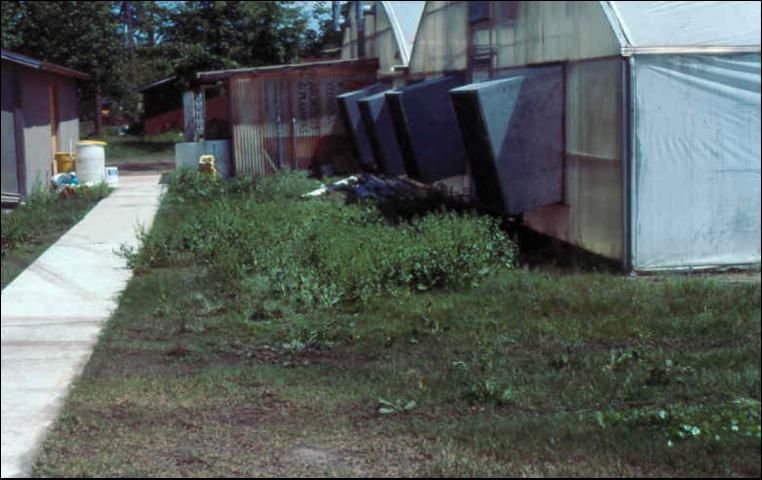

Harvesting and Handling
For maximizing yields and fruit quality, fruits must be harvested at the optimum stage of ripeness. Careful handling and transport from the greenhouse to grading and packing area is very important. Workers must be trained in all aspects of proper harvesting and handling procedures. Fruits for market must be packed in proper boxes which are appropriate for the size of the fruits and properly and attractively labeled (Figure 32).

Finishing Up the Season
Clean Up. Media can be dried out near the end of the season by letting plants draw out the water. Just turn off the irrigation system. It will take four to six days for wilting to begin. Remove plants before they become brittle to reduce the mess for the clean up crew. Drying out the bags will make them easier to handle.
Perlite media should be disposed of properly. Although, we have had success using the old media for a second crop, the practice is risky. Perlite can be distributed on a field and incorporated into the soil. Perlite can be used for soil mixes for container production of woody plants.
Irrigation lines and emitters should be cleaned with acid to remove lime deposits and fertilizer precipitates. A 1% acid solution should work in most situations. Acidification should be done at end of season since acidic solutions might injure plants. Flush system following acidification.
Additional Information
More information on hydroponic vegetable production is available from UF/IFAS Extension. The following is a listing of sources for this information.
Visit the the small farms website at http://smallfarms.ifas.ufl.edu.